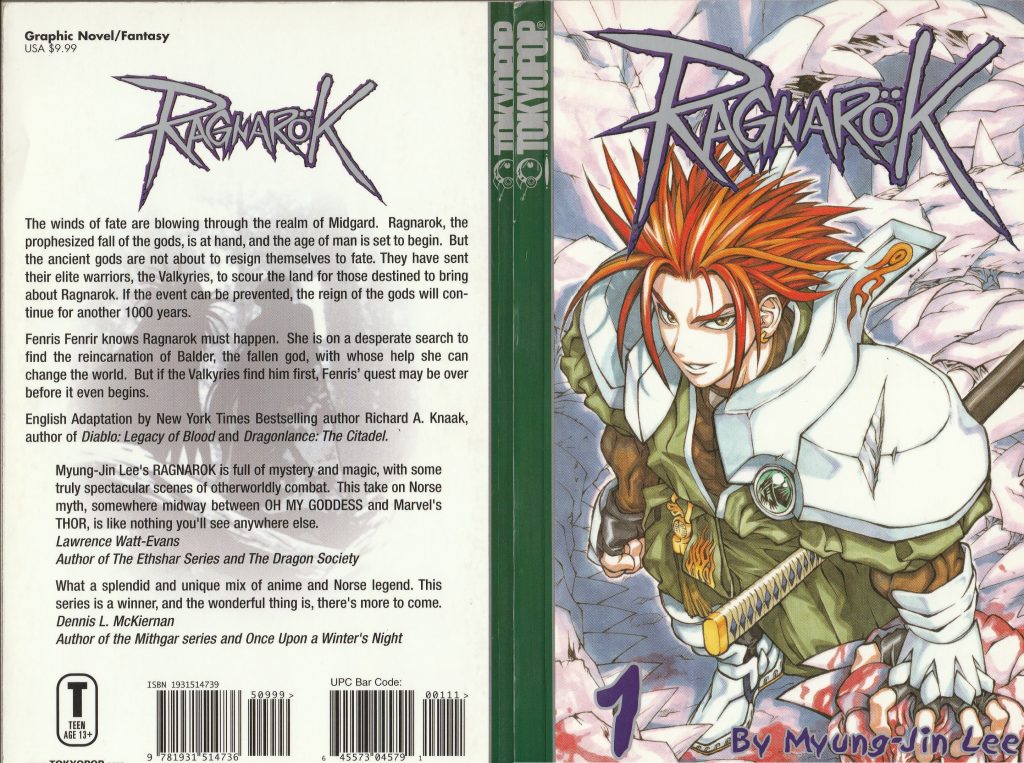





****
Ragnorak, is a 2002 fantasy Manhwa (or Korean comic) by Lee Myung-Jin. It was published by Daiwon C.I in Korea and by Tokyopop in North America. It started in 1995 and went on hiatus in 2001, spawning 10 volumes. It was popular enough to have a Ragnaroak MMORPG and Anime, Ragnorak the Animation, tie in.

A View From Above – We have our main swordsman, Chaos, looking up at the viewer. The overwhelming amount of white and gray makes it somewhat hard to tell, but he’s surrounded by a coiled up body, likely that of the “faceworms” Chaos and Iris fight this volume. However, it also frames Chaos quite nicely. Such a view point can do a good job of grounding the character themselves in one context while pointing their view towards another. It makes it look like they’re a smaller piece on a grander board, even being watched, but that that’s something they’re aware of and may even be prepared for. At the least, it’s a chance for Chaos to look badass.
Fate has it that the fall of Gods is destined to come about in the infamous Ragnorak. Midgard is on the precipice of Ragnorak and Fenris Fenrir is deadset on making it happen. The Gods, none too happy to end their reign and usher in the age of man, have dispatched the Valykyries to deal with Fenrir. If she can’t find the reincarnated Balder, a fallen god, she just may fail in her mission.
Fenris Fenrir – Magician Swordsman who seems to be trying to bring about Ragnarok. But first, she’s gotta find Balder before her enemies find her.
Chaos – Swordsman from Fayon village. Good friends with Iris Irine.
Iris Irine – Magician, also from Fayon, who fights alongside chaos. She’s daughter of the village leader.
Lidia – Expert Treasure Hunter (read: A FUCKING THIEF) that cons marks with her cat, Sessy. Bumps into Chaos and Iris in Alberta.
Skurai the Cursed Executor – An infamous killer who wields a cursed sword, Talatsu (something akin to Hotsuma’s sword, Akujiki).
It’s Norse Mythology, but Anime. Or maybe (more precisely) Anime, but Norse Mythology. From Sparkling Generation Valkyrie Yuuki and Marvel to Final Fantasy and Blazblue, references to Norse Mythology can be found in a myriad of places. Like many a mythology of cultures past, tales of the Norse pantheon and their adventures have become a part of today’s pop culture consciousness, maintaining the relevancy (to some degree) they’ve had since yesteryear.
Myung -Jin Lee seems to be making their own contribution here, with Ragnarok centering heavily around the event of the title’s namesake. On that note, though, I am a) not well versed enough in Norse Mythology to be able to tell if this a faithful retelling 2) highly doubtful that this volume is enough to tell if it was anyway and 3) utterly unconcerned with said status anyway. That may come as a surprise, but I don’t care very much about faithful retellings of mythology in my fiction. I expect such references to be no more than symbolism. If I wanted a faithful retelling of Norse Mythology, I’d go read Norse Mythology.
Mythological integrity aside, Ragnorak has that lovely fantasy hijinks/action mix that’s endearing enough. However, this volume has something of a “three lines, some waiting” problem. Of the three, or so, plot threads that are running, only one has immediate relevance to the plot (aye, it IS the main plot) with the others kinda poking around until we get an implication that they will get folded into the main plot and become relevant.
This isn’t a deal breaker, but there are a noticeable amount of characters introduced in this volume and together the plot can feel like it’s darting from place to place. Furthermore, you’re likely to miss on the first read-through that there are no chapters so it’s this uninterrupted run of plot from cover to cover. It’s pretty movie-like, in a sense, and I definitely have no qualms with the pacing. However, it’s a double edged sword because that separation of plot threads can do wonders for helping you contextualize them so they don’t feel like non-sequiturs. You go from exploration and an ambush to some bounty-work to some royal scheming to a bit of mystic divination to the handiwork of a savage killer to the introduction of the home town and WOO BOY, could some chapter breaks have staved off the ever encroaching feeling that we were drifting ever farther away from the main plot.
I very much like the art. Loose and cartoony when it needs to be, but slick and detailed enough everywhere else, it’s a treat to look at. HOWEVER, I must point my grubby little finger at the one thing that sticks out to me.
Like, my dude, what is it with you and black!?
Don’t get me wrong, I love me some black. But Ragnorak has this inconsistent use of it that is rather jarring. Thing is, this volume makes liberal use of gradients of various greys and whites, as well as sheen, to signify dark (if not shiny) outfits.

Problem is, they start wanting to have their cake and eat it too. They start throwing so much black on characters that it hides the silhouettes. But we can’t have THAT! So they add “de-censor” beams that remove the blackness and show off the silhouettes of (usually) the bust and hips. If it’s going to hide the shape of their body, why use that much black in the first place?
Bellyaching aside, I did find myself enjoying this volume of Ragnorak. Getting to see Fenrir duke it out with mystical beasts and the hijinks of Chaos, Iris and Lidia were definitely the high points of the experience. It hasn’t all come together to the point where the various plot threads all feel relevant yet, but Fenris and the Fate’s plot threads are just interesting enough to make me want to keep reading.
Continue?:



